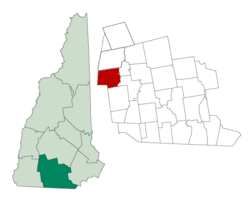Hancock, New Hampshire
Hancock, New Hampshire | |
|---|---|
Town | |
 | |
 Location in Hillsborough County, New Hampshire | |
| Country | United States |
| State | New Hampshire |
| County | Hillsborough |
| Incorporated | 1779 |
| Government | |
| • Board of Selectmen | Laurie Bryan John Hayes Lawrence Schwartz |
| Area | |
| • Total | 31.2 sq mi (80.9 km2) |
| • Land | 30.0 sq mi (77.6 km2) |
| • Water | 1.2 sq mi (3.2 km2) 4.00% |
| Elevation | 876 ft (267 m) |
| Population (2000) | |
| • Total | 1,739 |
| • Density | 58.0/sq mi (22.4/km2) |
| Time zone | UTC-5 (Eastern) |
| • Summer (DST) | UTC-4 (Eastern) |
| ZIP code | 03449 |
| Area code | 603 |
| FIPS code | 33-33700 |
| GNIS feature ID | 0873618 |
| Website | www.hancocknh.org |
Hancock is a town in Hillsborough County, New Hampshire, United States. The population was 1,739 at the 2000 census. Hancock is home to the Welch Family Farm Forest.
History
Hancock started as an unidentified settlement on the Contoocook River, in lands known as Society Land or Cumberland, which had been reserved for the proprietors of the lands which became New Hampshire. First settled in 1764, the town was set off from Peterborough and incorporated in 1779, named Hancock in honor of John Hancock. A landowner of 1,875 acres (8 km2) in the community, Hancock was the first governor of the state of Massachusetts, President of the Continental Congress, United States in Congress Assembled[1].and signer of the Declaration of Independence.
Almost every building on Main Street in downtown Hancock is listed on the National Register of Historic Places. Hancock's Meetinghouse is home to Paul Revere's #236 bell, which chimes on the hour, day and night. The town does not have traditional sidewalks, but gravel paths leading from home to home.
-
Main Street in 1907
-
Historical Society in 1915
-
Old Library in c. 1905
Notable inhabitants
- Oren B. Cheney, abolitionist, Free Baptist preacher, founder of Bates College
- Person C. Cheney, U.S. Senator from New Hampshire
- Joseph Grew, United States Ambassador to Japan
- Jay Pierrepont Moffat, United States Ambassador to Canada
- Lilla Cabot Perry, artist
Geography
According to the United States Census Bureau, the town has a total area of 80.9 km² (31.2 mi²). 77.6 km² (30.0 mi²) of it is land and 3.2 km² (1.2 mi²) of it is water, comprising 4.00% of the town. Hancock is drained by the Contoocook River. Powder Mill Pond is in the east, and Nubanusit Lake is on the western border. Skatutakee Mountain, the highest point in Hancock, has an elevation of 2,002 feet (610 meters) above sea level. Hancock lies fully within the Merrimack River watershed.[2]
Demographics

As of the census² of 2000, there were 1,739 people, 706 households, and 494 families residing in the town. The population density was 22.4/km² (58.0/mi²). There were 814 housing units at an average density of 10.5/km² (27.2/mi²). The racial makeup of the town was 98.39% White, 0.23% African American, 0.29% Native American, 0.40% Asian, 0.06% from other races, and 0.63% from two or more races. Hispanic or Latino of any race were 0.40% of the population.
There were 706 households out of which 31.2% had children under the age of 18 living with them, 62.6% were married couples living together, 5.1% had a female householder with no husband present, and 29.9% were non-families. 25.1% of all households were made up of individuals and 10.3% had someone living alone who was 65 years of age or older. The average household size was 2.46 and the average family size was 2.94.

In the town the population was spread out with 25.0% under the age of 18, 3.9% from 18 to 24, 26.0% from 25 to 44, 28.3% from 45 to 64, and 16.8% who were 65 years of age or older. The median age was 43 years. For every 100 females there were 92.2 males. For every 100 females age 18 and over, there were 90.2 males.
The median income for a household in the town was $55,000, and the median income for a family was $64,423. Males had a median income of $40,000 versus $31,200 for females. The per capita income for the town was $29,445. About 2.7% of families and 3.8% of the population were below the poverty line, including 2.6% of those under age 18 and 4.1% of those age 65 or over.
Sites of interest
- Hancock Historical Society Museum
- Very Long Baseline Array
References
- ^ President Who/ Forgotten Founders, By Stanley L. Klos 2004
- ^ Foster, Debra H. (1995). Water Use in New Hampshire: An Activities Guide for Teachers. U.S. Department of the Interior and U.S. Geological Survey.
{{cite book}}: Unknown parameter|coauthors=ignored (|author=suggested) (help)



